 View Blacklighting in Box Canyon then investigate bugs at night on your own!
View Blacklighting in Box Canyon then investigate bugs at night on your own!

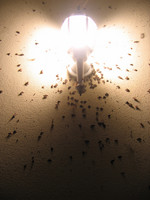
Bugs attracted to a porch light at night. © 2006 Anah
Observing Bugs at Night
Many insects are attracted to light. You don’t need to go out to the desert or the mountains to observe insects at night. Many species live in the city, so you can make great observations around any light source such as:
- a fluorescent street light
- a camping lantern set out in a park or near a patch of bushes
- a spot light in your backyard or driveway
- even an incandescent light on your front porch!
Utilizing these light sources, you can explore your yard and you can also get your parents to go out with you on a nightime bug watching walk in your neighborhood. Go from street light to street light, or take a lantern, put it down in different spots and then wait for insects to come.
Some Variables That Will Affect What You Will See
You will get different kinds of insects depending on:
- The area where you make your observations: There will be different plants in different areas, and the temperature and humidity will vary from spot to spot.
- The wavelength of your light source: Different kinds of insects respond to different wavelengths.
- The phases of the moon: You’ll get fewer insects with a brighter moon.
- The time of year: In Tucson, you’ll find at least some insects almost year round, except during the coldest winter nights. However, insects are most active during spring, fall, and especially during monsoon season.
What You May See:
- web spinners running backwards
- beetles or walking sticks mating
- moths buzzing
- praying mantids and assassin bugs pouncing on their prey
- If you are really still, you may also see geckos coming in and snatching a few juicy bugs for their supper.

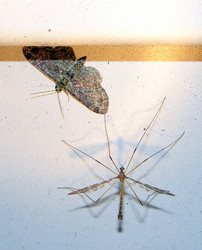
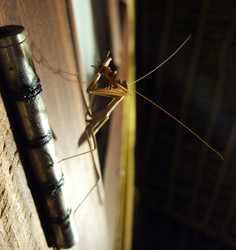
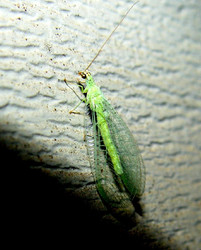
Some insects you may see in your neighborhood at night: A moth and a cranefly, © 2005 Jenn Forman Orth. A praying mantis munching on a cockroach © 2005 Owen Rodda. A lacewing © 2006 talkingplant.
How to Observe, Equipment and How to Use It
Don’t just hurry from light to light. Stick around and observe what’s going on in a particular spot. You may make some great observations!
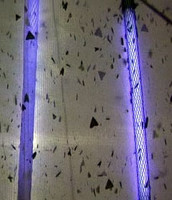
Insects on a sheet reflecting light from a fluorescent blacklight. © 2006 Michelle Lanan
- Take a flashlight to put an extra spotlight on interesting bug activities.
- A low-powered magnifying glass (5-10x) will also come in handy.
- A small glass jar will let you catch interesting creatures for a closer look.
- It’s also fun to take pictures of nighttime bugs with a digital camera. Be sure to turn on your flash!
- A notebook: take notes about the things you see. Make sure to write down the date and time when you make your observations. Briefly describe the weather and other physical conditions; for example: How hot or cold is it? Is it cloudy or humid? Has it rained recently? Or has it been very dry? What's the phase of the moon? If you go nighttime bugging regularly, you'll accumulate an interesting record of how the activities of the creatures in your neighborhood change with these other variables.
- Get an insect field guide to help you learn about the insects you encounter. Good field guides are available from the Audubon and Peterson Field Guide series. Once you have figured out what kinds of insects live in your neighborhood, you can read more about them and look at pictures online.
Techniques for Attracting More Bugs
In order to attract even more insects, you can get a small blacklight (available for about $20 on the internet). If your parents have an emergency car flashlight with a fluorescent bulb, you can also get a blacklight bulb at a hardware store and turn it into an instant bug light.
Whether you are using a real blacklight or a camping lantern, it always helps to boost your light by having it reflected off a white sheet. You can put the sheet down on the ground and put your light on top of it; even better, you can hang up the sheet (using a rope and clothespins) and then suspend your light in front of it. Insects will fly in from all directions and settle on the sheet where it’s easy for you to observe them and collect them.

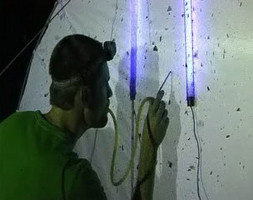
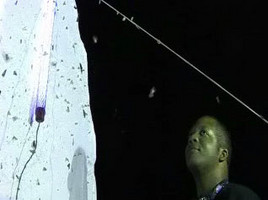
Professional nighttime bug hunters: University of Arizona graduate students collecting insects from a blacklight sheet in Box Canyon. © 2006 Michelle Lanan
Things to think about
- Why do insects come to lights?
- Why are insects out at night?

 This page was developed
as part of the project "New Strategies for Life Sciences Outreach in
Arizona: Developing a Digital Library of Audio and Video Features in the
Context of the Tree of Life Web Project" funded by the “Anyplace
Access for Arizonans” Initiative under the
This page was developed
as part of the project "New Strategies for Life Sciences Outreach in
Arizona: Developing a Digital Library of Audio and Video Features in the
Context of the Tree of Life Web Project" funded by the “Anyplace
Access for Arizonans” Initiative under the 



 Go to quick links
Go to quick search
Go to navigation for this section of the ToL site
Go to detailed links for the ToL site
Go to quick links
Go to quick search
Go to navigation for this section of the ToL site
Go to detailed links for the ToL site